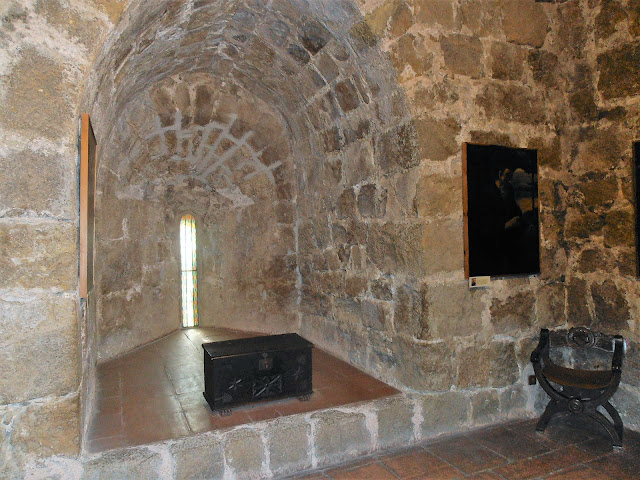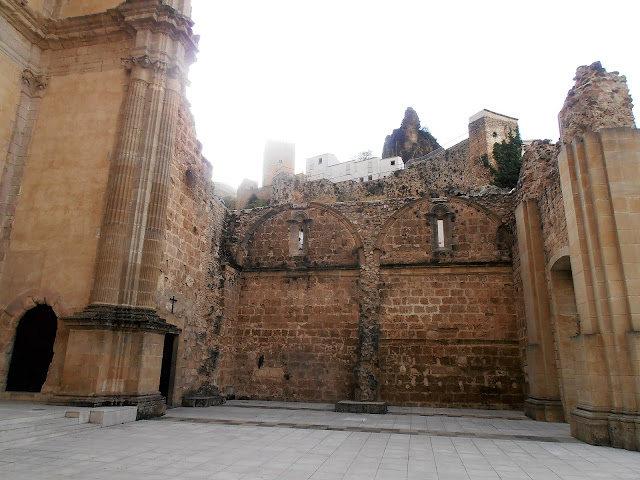Search This Blog
Writings from Jaen, Andalucia. Travel, Food, Wine, Living, Musing, Reviewing, Tapas Tasting, Trip Planning......
Featured Posts
- Get link
- Other Apps
Cazorla Town - Rocks and Ruins
A dilapidated Moorish hilltop fortress, reminder of a bloody
past, looks down on the reconstructed Castillo de la Yedra, also known as the
castle of four corners, its 30-metre tower not as impressive from below as
within. The giant steps an assault course. ¨Why are the steps so high? ¨ I ask
Pablo the guide, having hauled myself up. ´ Because the Moors were short and
when wearing armour it made it very difficult for them to ascend. ´ How simply
logical.
 |
| Castillo de la Yedra, Cazorla |
I´m in the Plaza de Santa Maria, the oldest square in
Cazorla town, gateway to Spain´s largest protected area; Parque Natural de
Sierra de Cazorla, Segura y Las Villas. This is Jaén province, north-east of
Andalucía bordering with Granada province to the south and the region of
Castilla-La Mancha to the north-east.
An army of hexagonal white parasols stand shoulder to
shoulder battling with the sun. Above them a mass of unadulterated blue. An
upright wall of grey limestone rock stands in the background, as impressive as
the ruins in front. My eyelids sweat behind sunglasses as I sink gratefully
onto a seat under the shades. The chair hot, to my damp back, says the parasols´
battle had been briefly lost.
 |
| Ruin of Santa Maria, Cazorla |
´No hay comida´ the waitress says ´Vamos a cerrar.´ I´ve
already eaten. It´s a quick, cold drink I need. Lunch time is well over, yet
most tables across the square are still occupied, mainly Spanish surprisingly,
at this mad dog hour. My waitress stacks chairs and folds the sun warriors around
me. I focus on my almost empty Cruzcampo beer´s frosted glass, now sitting in
its own puddle, dripping, rather welcomely, at every sip.
The 16th century ruin of Santa María stands watch over the plaza, it´s said to be the only church built over a river, which now flows under the plaza. Devastated by floods in 1694 and attacked by French Troops in the Napoleonic War, the ruin has a new role as the Tourist Office´s location and at times a stage. One of its towers is still intact.
 |
| Spiral Stone Staircase, Santa Maria, Cazorla |
Slowly, I climb the stone snail staircase, a feat in the heat, 63, 64, 65. I shield my eyes as they refocus. A jumble of white dwellings in the passage-like Moorish streets spread before me with olive groves and mountain ranges beyond. Behind I´m dwarfed by the ever-present rock backdrop, I spy one or two large boulders high up and shudder at how quick this remaining tower could be no more. My descent is speedy.
Dry, extremely dry, red peppers adorn a restaurant´s façade.
A large hairy dog bounds into the fountain only to be yelled at by its owner.
Everything is else slow moving. The waiters don´t hurry, even the parasols
barely flutter.
 |
| Red Peppers Drying, Cazorla |
- Get link
- Other Apps
Popular Posts
What´s the Difference Between an Alcazar and an Alcazaba?
- Get link
- Other Apps
Monday Morning Photo - Wisteria Time in Andalucia
- Get link
- Other Apps
